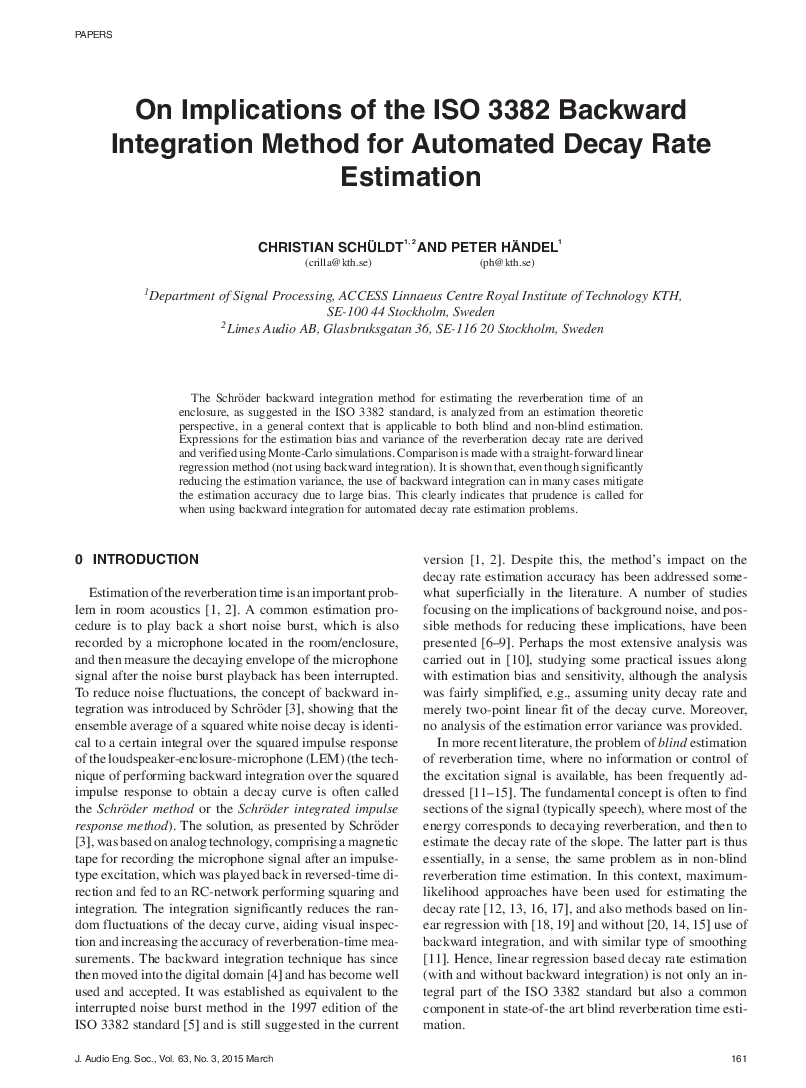Home / Publications / E-library page
You are currently logged in as an
Institutional Subscriber.
If you would like to logout,
please click on the button below.
Home / Publications / E-library page
Only AES members and Institutional Journal Subscribers can download
Methods for estimating the reverberation time in room acoustics have always been considered an important problem. A common approach uses Schröder’s backward integration method because it reduces variability, which is interpreted as meaning that it produces a more accurate estimate. This article analyzes this assumption in contexts applicable to both blind and nonblind estimation. Expressions for the estimation bias and variance of the reverberation decay rate are derived and verified using Monte Carlo simulations. The results confirm that backward integration does indeed significantly reduce the variance of decay rate estimates but at a cost of an increased and possibly large bias, which reduces the accuracy of the result. Prudence is therefore required when using backward integration for automated decay rate estimation tasks.
Author (s): Schüldt, Christian; Händel, Peter
Affiliation:
Department of Signal Processing, ACCESS Linnaeus Centre Royal Institute of Technology KTH, Stockholm, Sweden; Limes Audio AB, Stockholm, Sweden
(See document for exact affiliation information.)
Publication Date:
2015-03-06
Import into BibTeX
Permalink: https://aes2.org/publications/elibrary-page/?id=17575
(1369KB)
Click to purchase paper as a non-member or login as an AES member. If your company or school subscribes to the E-Library then switch to the institutional version. If you are not an AES member Join the AES. If you need to check your member status, login to the Member Portal.

Schüldt, Christian; Händel, Peter; 2015; On Implications of the ISO 3382 Backward Integration Method for Automated Decay Rate Estimation [PDF]; Department of Signal Processing, ACCESS Linnaeus Centre Royal Institute of Technology KTH, Stockholm, Sweden; Limes Audio AB, Stockholm, Sweden; Paper ; Available from: https://aes2.org/publications/elibrary-page/?id=17575
Schüldt, Christian; Händel, Peter; On Implications of the ISO 3382 Backward Integration Method for Automated Decay Rate Estimation [PDF]; Department of Signal Processing, ACCESS Linnaeus Centre Royal Institute of Technology KTH, Stockholm, Sweden; Limes Audio AB, Stockholm, Sweden; Paper ; 2015 Available: https://aes2.org/publications/elibrary-page/?id=17575
@article{schüldt2015on,
author={schüldt christian and händel peter},
journal={journal of the audio engineering society},
title={on implications of the iso 3382 backward integration method for automated decay rate estimation},
year={2015},
volume={63},
issue={3},
pages={161-173},
month={march},}